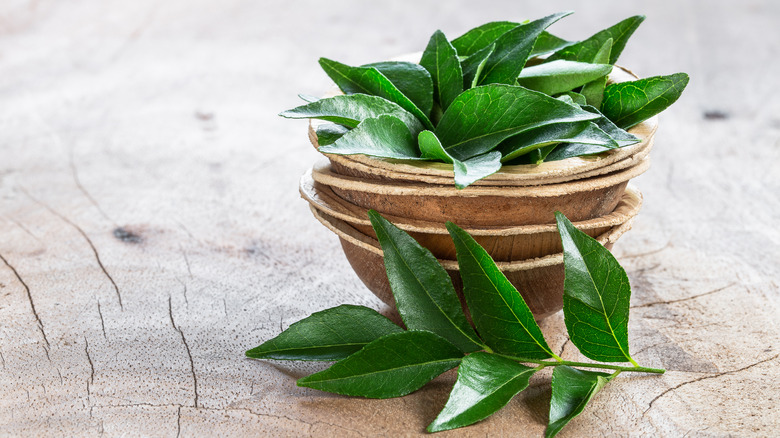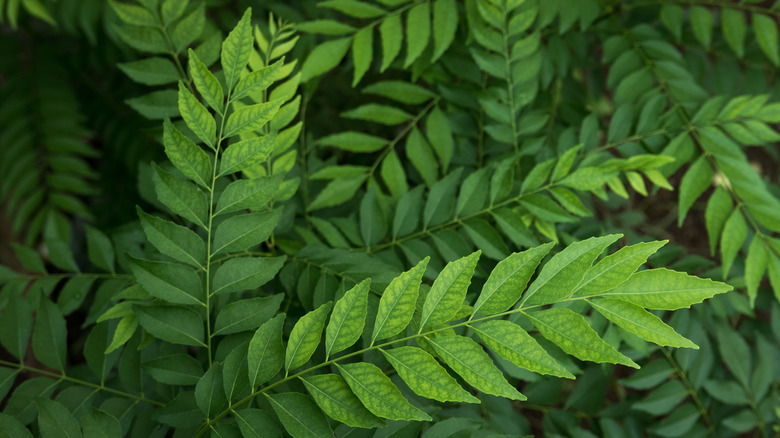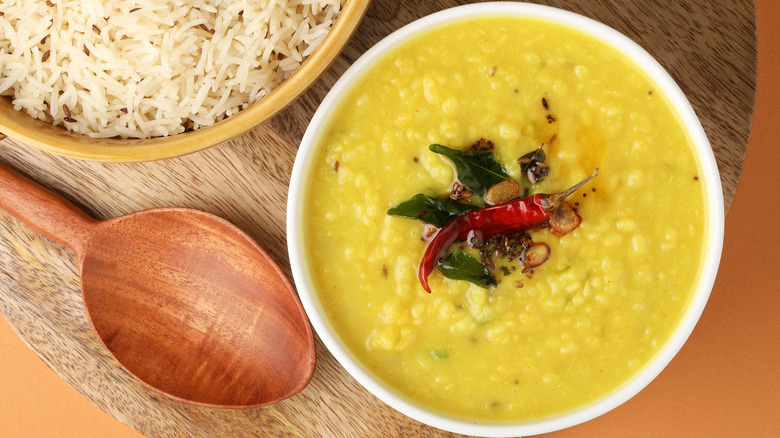The Easiest Way To Store Curry Leaves In The Fridge
Fresh curry leaves offer a unique burst of aroma and flavor, invoking notes of citrus, herbs, and savory elements reminiscent of cumin and asafoetida (a resin that transforms into an allium-like additive when cooked). Not to be confused with curry powders, which are spice blends, fresh curry leaves are literal leaves. They're shiny, bright green, petite, and their shape is reminiscent of bay leaves.
When it comes to herbs and produce, the challenge after purchasing is figuring out how to store them to prolong their freshness and fit them easily into the fridge. Experienced cooks may know that these green spices are sold attached to branches, but for others, the rows of stems and leaves may be a surprise. While the leaves are easy to detach, the simplest way to store them in the fridge is to keep the leaves attached to the thinner stems before stowing them away.
To prepare the curry leaves for storage, give them a quick rinse, or wipe them down with a wet paper towel. Then, pat them dry with a dry towel. After that, place the leaves, whole or individually, into an airtight container or resealable bag, and store them for up to two weeks.
Other methods for storing curry leaves
Not everyone has access to fresh leaves, or they may purchase them in bulk quantities that are impossible to use up within two weeks. If that's the case, there are other ways to store a surplus of seasoning, although the leaves will become less pungent. One method is to freeze them. You can do so either by detaching the individual leaves from the stems and freezing them before placing them in an airtight container, or by putting the entire branch into a resealable plastic bag.
Another approach is to dry the leaves. This can be done with a dehydrator or, depending on your climate, by leaving the branches spread out on a tray and exposed to the air. Some people prefer to dry them in the sun, whereas others believe this diminishes their flavor, and opt to keep them in a dark, dry spot for a few days. Regardless of the method, you may need to use extra dried leaves to replicate the fragrant fresh ones.
If you manage to find ultra-fresh cuttings or have a friend with a curry leaf plant, another option is to patiently grow your own. The best method is to propagate from a cutting rather than starting from seed, which involves soaking the branch in water to encourage root growth. Try to ensure it receives plenty of sunlight and warmth to mimic its tropical native climate — and don't leave it outside during winter.
Cooking with fresh curry leaves
Curry leaves are a vibrant and essential part of many Southeast Asian cuisines, particularly in southern India. Unlike bay leaves, these tender greens are versatile and safe to eat. Cooks enhance their dishes with flavor by adding the leaves directly to sauces, and by quickly blooming them in hot oil along with other seasonings for maximum potency.
Tadka or tarka, the spice tempering technique, is also known as chaunk or chhonk, among other terms. Sizzling oil is then poured over cooked porridges, lentils, and grains, but it's also an excellent foundation for a nuanced sauteed dish. While not every dal requires a curry leaf topping — chana dal with golden garlic tarka, for example — they're likely enhanced by its addition.
Don't confine your use of curry leaves to stovetop cooking. This fresh ingredient also excels in creative baking interpretations, like Indian green chile and cheddar shortbread. Incorporate it into gently spiced bread doughs to produce a snack or a warming accompaniment to a rich meal.



